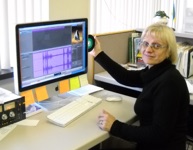










The Ukrainian Canadian Research and Documentation Centre evolved from a filmmaking project of the Famine Research Committee. It has continued to collect materials for the production of documentary films, which has remained one of its main objectives.
Sharing the Story – The Holodomor Famine Genocide in Ukraine 1932-33 was a project created by the Ukrainian Canadian Congress in partnership with the UCRDC and begun in the summer of 2008. The project was made possible with the support of the Department of Canadian Heritage through the Canadian Culture Online Strategy and several Ukrainian Canadian community organizations.
The aim of the project was to collect interviews with Famine survivors. Over eighty interviews with Holodomor survivors were filmed all across Canada. The interviewees were both men and women, from 78 to 99 years of age, most of whom had been children during the Famine.
A website was created out of the material collected. It features filmed excerpts of the interviews, in the original Ukrainian, with written translations in English. The site also has historical and statistical material as well as scholarly articles on the subjects of the Famine and genocide.
The website can be found on www.holodomorsurvivors.ca.


Documentation of Ukrainians
who rescued Jews during the Holocaust.
Approached by Leonid Finberg of the Judaica Institute in Kyiv, the UCRDC has agreed to collaborate on a project on Ukrainian-Jewish relations. Titled “Chy ya storozh brata svoho” (Am I my brother’s keeper) the project involves both a research element and a public awareness campaign.

Oral History Digitization
A major treasure of the UCRDC is its oral history archive - audio and video recordings of interviews, collected over more than 25 years, with people who took part in some of the most significant events in contemporary Ukrainian history.
Today most libraries, archives and museums are digitizing their collections with the aim of giving wider access to them, particularly through the Internet. This is especially important for collections recorded on magnetic tape – audio and video – because, unlike paper records, which have a long life-span, analog sound and image recording media are subject to deterioration within a few decades. Until recently, audio and video archivists handled this situation by periodically re-recording on fresh tapes. However, when analog recordings are copied, there is always a loss of quality while digital copies are identical to the original. Digitization definitely provides a better method for the preservation of recordings.
Thanks to a five year agreement to organize and analyze the UCRDC oral history archive, made between the Peter Jacyk History of Ukraine program of the Canadian Institute of Ukrainian Studies (CIUS) and the Institute of Historical Research of the University of Lviv and the Ukrainian Catholic University (UCU), the archival project will take place over the next five years (2008/9 – 2012/13). CIUS has agreed to finance it through the John Kolasky scholarship fund, while the University of Lviv and UCU will provide the specialist personnel who will implement the project.
The first part of the five-year archival project is the digitization of audio recorded interviews. It began in the fall of 2009 when Oksana Dmyterko from the Lviv Institute of Historical Research came to work at the Centre. Ms. Dmyterko transferred to digital media almost 220 hours of recordings, about one-half of the audio archive. The work had to proceed at its own pace because the recordings have to be transferred from tape to computer in real time. The software program used was Garage Band which transferred the sound into MP3. The transfer was done using a professional recorder Tasscam 122mkII and a new iMac. Technical assistance was provided by Andrij Holowatyj.
The recordings covered a wide variety of categories of interviews: members of the Galicia Divison; people who had gone through DP camps; ostarbeiters and people from the General-Gouvernment who were forcibly taken to work in Germany; members of the Ukrainian Insurgent Army (UPA); Ukrainians who saved Jews; women who had lived through the occupations of Ukraine in WWII.

Oksana Dmyterko from the Lviv Institute of Historical Research, working on the digitization of UCRDC audio tapes.

-
‣Home

